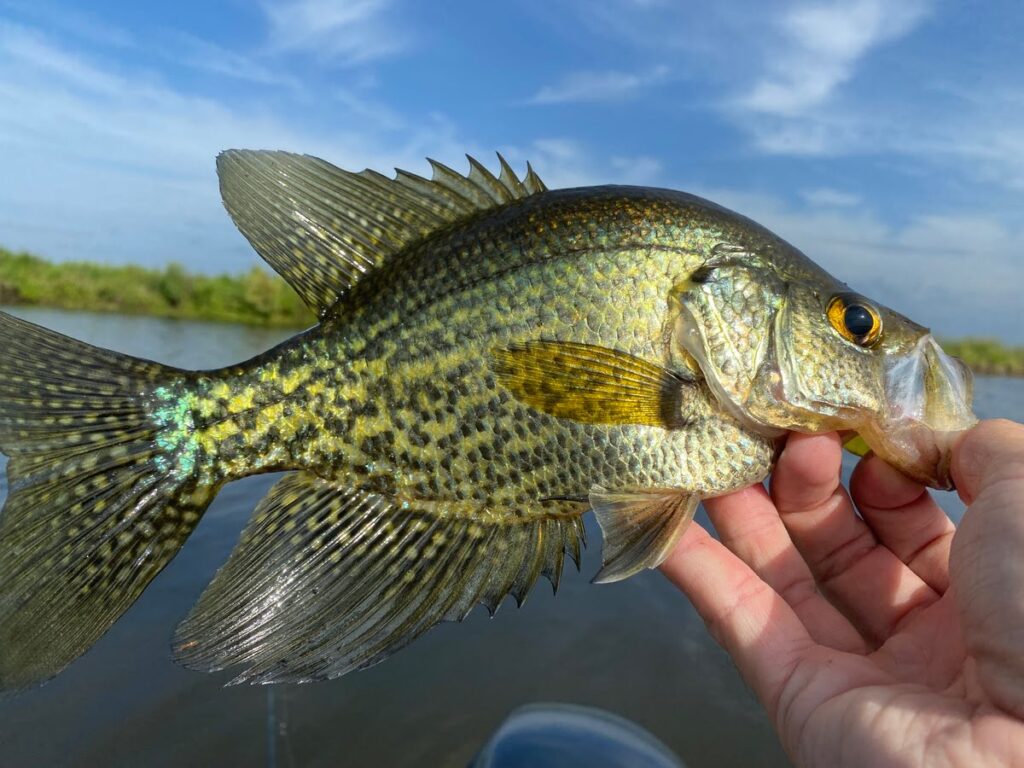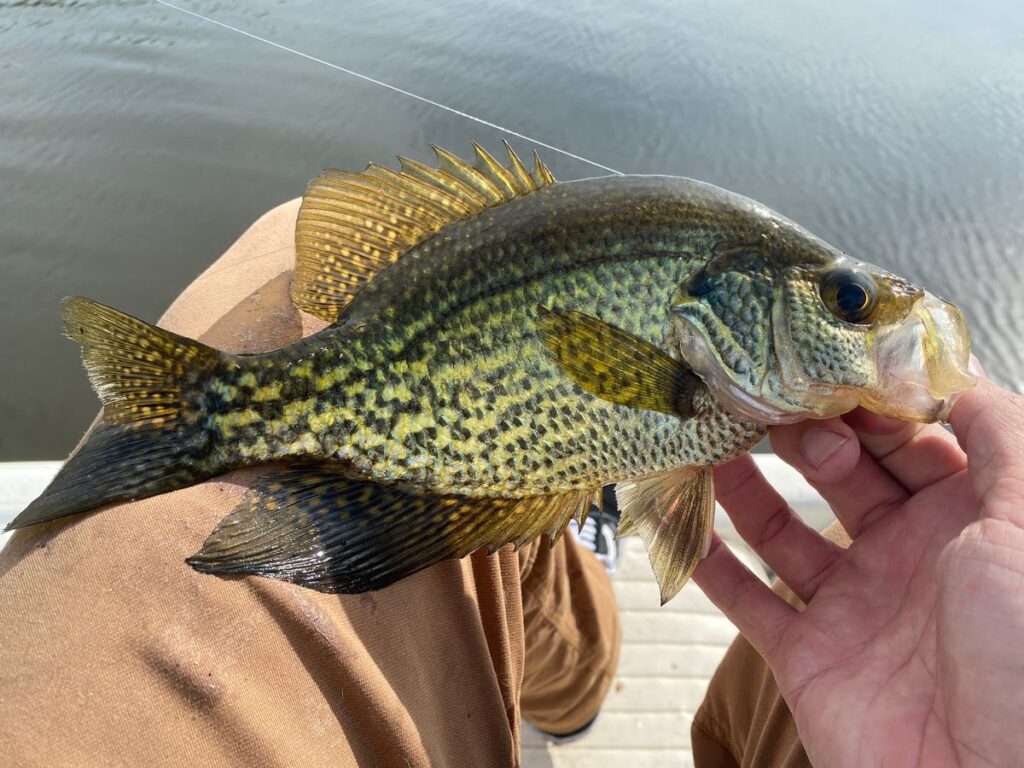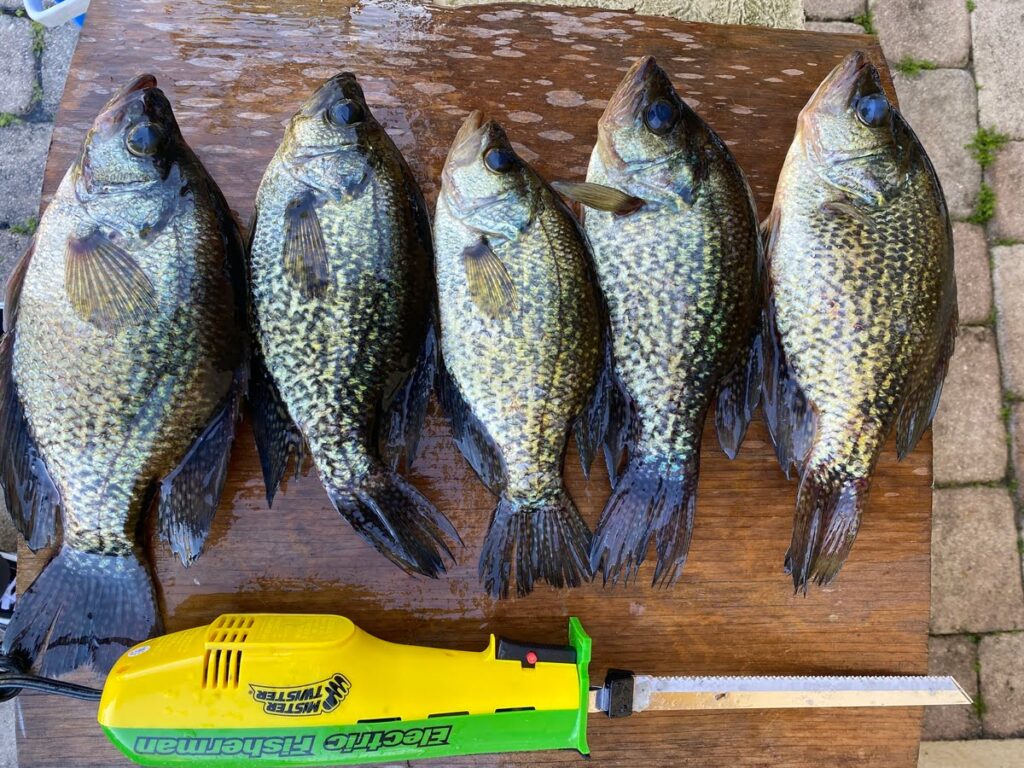While lepomid sunfish and black bass get the lion’s share of the love in the sunfish family centrarchidae, crappies in the genus poxomis are often ignored.
They’re the bigger cousin of more common sunfish like bluegill, but can’t quite get as big as largemouths or other bass.
…at least, not most of the time! On rare occasions in very particular bodies of water, crappies can reach absolutely behemoth sizes.
On even rarer occasions, an angler has a chance to connect with one of these monster crappies via a tight fishing line!
It should be noted that there are 2 different species of crappie, the black crappie and the white crappie.

We’ll explain the differences between the two later in the article, but for now just know that the records for each are kept separately. There are indeed 2 world records for crappie, one for each species.
Now, without further ado, let’s break down the size measurements, geography, angling techniques, and everything else you need to know about the least crappy crappies on planet Earth!
Table of Contents
Size Matters Here: The Record Crappie Breakdown
While the average crappie caught by anglers ranges from 1-2 pounds, the record-setting aquatic monsters put on more than double that weight.
The world record white crappie, caught by Fred Bright, was weighed in at an eye-popping 5 pounds and 3 ounces upon being caught. No length was recorded for this catch, but the 17 to 20 inch range is likely a good estimate.
But that’s still not as big as the world record black crappie, caught by Lionel “Jam” Ferguson, which weighed an unbelievable 5 pounds and 7 ounces. That’s one heck of a slab if I do say so myself! This fish was measured at 19.25 inches long, an equally amazing length to match its incredible mass.
Where Were the World Record Crappies Caught?
Crappies are generally more at home in slower flowing water. Their rounded body shape is great for maneuverability, but less so for fighting strong currents.
As such, it’s no surprise that slower moving waters were home to both world record fish!

Ferguson’s world record black crappie was caught in a small private pond near Knoxville, Tennessee. It’s unfortunately not open for the public to fish, but it’s noted as being very weedy and deep, with clear water.
If you want to beat this record, these are the conditions to look for!
Bright’s world record white crappie was landed on the Yocona River in Mississippi, in the waters just beneath the Enid Dam. This water is cloudier and faster (but still not too fast) than that which housed the previously mentioned black crappie.
This dam is responsible for creating the massive reservoir known as Enid Lake, but surprisingly the crappie was caught in the waters below. It’s possible that the spillway provided a constant stream of food for this giant to feast on!
What Techniques were Used to Catch these Giants?
Unfortunately, the world record white crappie was caught many decades ago, and the exact way it was caught is unknown. Fred Bright used an Action fishing pole from Orchard Industries with a reel from Denison-Johnson.
Some say that a live minnow was used, as that was often the ‘default’ bait for crappie fishing in the region, serving as a possible reason for why the exact type of bait was never mentioned. But this is pure speculation, and what exactly his legendary fish bit has been lost to the sands of time.

The black crappie record, however, was just broken back in 2018! So we know for a fact that Jam Ferguson had a 1/8 ounce jig head tied onto the end of his line, with a Kalin’s 2-Inch Triple Threat (in the John Deere color pattern) grub on the hook.
These grubs are a simple, easy-to-use bait that is typically jigged along the bottom. Sometimes less is more- these types of grubs are nearly universal for a reason! You can read our article on how to catch crappie with a jig if you’re looking for some pointers.
Set in Stone: These Records are Hard to Break!
Though the record black crappie was recently caught in 2018, the previous record was set thirteen years prior in 2005. Obviously the biggest fish on the planet isn’t popping up every day!
The situation is even crazier for the white crappie record, as Bright’s fish was landed all the way back in 1957! Nearly seventy years have passed since it was caught, and a bigger white crappie has never been seen.
With every new record set, anglers are approaching the absolute limits of fish biology. Under perfect conditions, just how big exactly can a crappie get? The world may never know for sure, but every new record moves that bar higher and higher!
Catching a world record fish requires verification, of course.
State wildlife officers can usually be reached by phone to come and verify a catch, so be sure to check online and have their number on hand. A live well or cage to keep your fish in will also help a lot!
See Also: What is the Best Time of Year to Catch Crappie
A Tale of Two Crappies: Black and White
While the name ‘crappie’ gets thrown around a whole lot in the fishing community, it should be noted that there are actually two different varieties; the black crappie (Pomoxis nigromaculatus) and its close cousin, the white crappie (Poxomis annularis).
The International Game Fish Association (IGFA) records separate world record statistics for each species, so it’s important to be able to tell them apart if you’re aiming to dethrone one of the reigning crappie champs!
These fish are similar, but still distinct. Despite their names, color is not always the best way to tell crappies apart. While white crappies are generally lighter than black crappies, this is not always true and both species can vary widely in color.
White crappies often have vertical bars along the sides of their bodies, while black crappies opt for an irregular pattern of spots instead. White crappie also tend to have a longer body (think bass) while black crappie are a bit more rotund (think bluegill).
If you want to get anatomical about it, check the hard spines that make up the fish’s dorsal fin (just be careful not to get poked!) Black crappies have 7-8 of these dorsal spines, while white crappie only possess 5-6. This is the most surefire way to tell them apart in the field!
Black crappies prefer clear, undisturbed water, while white crappies are less choosy and can tolerate a wider variety of environments. Both are native to the Eastern US, but have been widely introduced across the entire continent.
Hi-Tech Fishing: The Genetic Analysis of World Record Catches

To complicate the matter further, black and white crappie can hybridize in the wild, creating fish with a combination of traits inconsistent with either species. Only genetically pure fish are allowed to be counted for a record!
How does one ensure this purity? In the past, a fish simply had to look the part. Nowadays, genetic tests can be run to take a peek under mother nature’s hood and determine nearly any organism’s genetic makeup!
While Bright’s fish was caught before the days of this technology, Ferguson’s black crappie was indeed genetically analyzed by the State of Tennessee to ensure that it was a pure black crappie.
Thankfully, such tests do not hurt the fish! A small clipping from a dorsal or tail fin (along with witnesses to confirm it came from the same fish) is all the material you need to run such a test while the fish swims free.
Conclusion
Crappies are the only one of the sunfish caught for food more often than for sport, but these records go to show you that they can be just as much of a trophy fish as bass!
With crappie so widely introduced across the country, there’s no telling where the necxt record fish will come from. Maybe it’ll be from some water near you! Only time will tell, so get out there and slay some monsters.
If you haven’t guessed yet, I love fishing and everything about it!
To learn more about why I started Panfish Nation, visit the About page and follow along on Social Media:


Download a copy of my FREE Lure Color Selection Chart & Knot Guide!
Stay up to date with fishing reports, tackle reviews, industry news, and much more! We respect your privacy, unsubscribe at any time.
